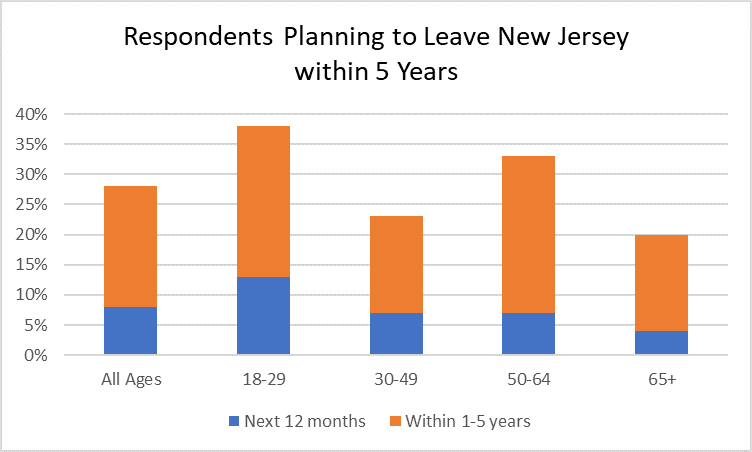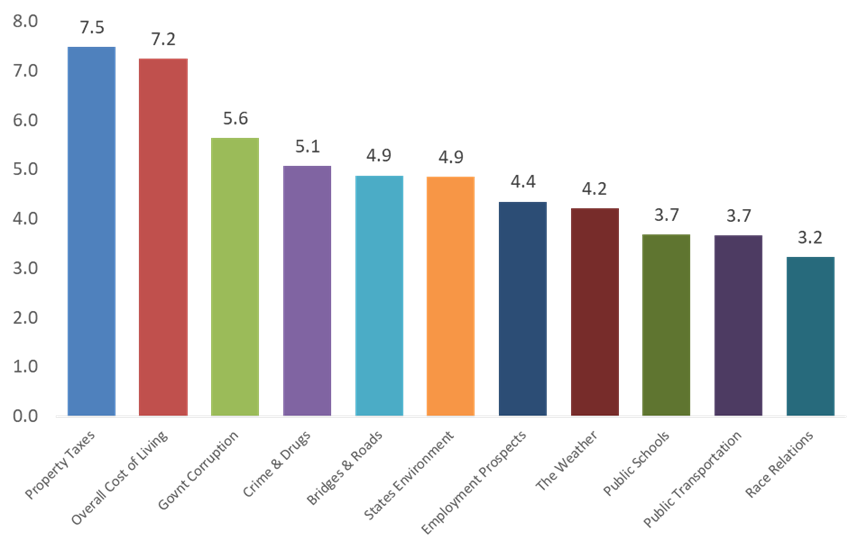NJ To Become Wasteland: 44% Of Residents Plan To Flee State
Thanks to the highest property taxes in the nation and an unsustainable cost of living, 44% of New Jersey residents plan to leave the state in the ‘no so distant future,’ according to a recent survey from the Garden State Initiative (GSI) and Fairleigh Dickenson University School of Public & Global Affairs.

Committing to a more solid time frame, 28% say they are planning to leave within five years, and 39% say they will do so over the next decade, according to Insider NJ.
Unsurprisingly, Property Taxes and the overall Cost of Living were cited as the main drivers. The results also debunk two issues frequently cited in anecdotal accounts of outmigration, weather and public transportation, as they ranked 8th and 10th respectively, out of 11 factors offered.
The desire to leave the Garden State was reflected most strongly among young residents (18-29) with almost 40% anticipating leaving the state within the next five years. At the other end of the spectrum, a third (33%) of those nearing retirement (50-64) plan to leave within the next five years. –Insider NJ
“These results should alarm every elected official and policymaker in New Jersey, said GSI’s president, former Chris Christie Chief of Staff Regina Egea. GSI focuses on providing “research-based answers to fiscal and economic issues” facing the state.
“We have a crisis of confidence in the ability of our leaders to address property taxes and the cost of living whether at the start of their career, in prime earning years, or repositioning for retirement, New Jersey residents see greener pastures in other states. This crisis presents a profound challenge to our state as we are faced with a generation of young residents looking elsewhere to build their careers, establish families and make investments like homeownership.”
After taxes and a high cost of living, government corruption and concerns about crime and drugs concerned citizens the most. Insider notes that there were no significant differences in responses across income levels.
Methodology
The survey was conducted by live callers on both landlines and cellular phones between September 26 through October 2, 2019, with a scientifically selected random sample of 801 New Jersey adults, 18 or older. Persons without a telephone could not be included in the random selection process. Respondents within a household are selected by asking randomly for the youngest adult currently available. The interview was conducted in English and included 253 adults reached on a landline phone and 548 adults reached on a cell phone, all acquired through random digit dialing.
The data were weighted to be representative of the non-institutionalized adult population of New Jersey. The weighting balanced sample demographics to target population parameters. The sample is balanced to match parameters for sex, age, education, race/ethnicity, region and phone use. The sex, age, education, race/ethnicity and region parameters were derived from 2017 American Community Survey PUMS data. The phone use parameter was derived from estimates provided by the National Health Interview Survey Early Release Program.[1][2][3]
Weighting was done in two stages. The first stage of weighting corrected for different probabilities of selection associated with the number of adults in each household and each respondent’s telephone usage patterns. This adjustment also accounts for the overlapping landline and cell sample frames and the relative sizes of each frame and each sample. This first stage weight was applied to the entire sample which included all adults.
The second stage of the weighting balanced sample demographics to match target population benchmarks. This weighting was accomplished using SPSSINC RAKE, an SPSS extension module that simultaneously balances the distributions of all variables using the GENLOG procedure. Weights were trimmed to prevent individual interviews from having too much influence on the final results. The use of these weights in statistical analysis ensures that the demographic characteristics of the sample closely approximate the demographic characteristics of the target population.
Read the rest here.
Tyler Durden
Wed, 11/27/2019 – 23:10
via ZeroHedge News https://ift.tt/2OK8AlK Tyler Durden
